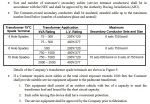PVfarmer
Senior Member
- Location
- Newport County, Rhode Island, USA
But that is 2% of that circuit, not of the whole array. You do not add those 2% numbers to get the total losses for the system. If you have four strings that each lose 2%, your total losses are the same: 2%.
I'm honestly not aware of where I or the software did that.
I agree, if you have 8 DC combiner to inverter input "home runs", each loses 2% and all 8 lose 2%.
One thing- I goofed a bit- 4 AWG is 2.0% and 500kcmil is 1.8%, for the same 1000'.
Yet the 4 AWG supposedly puts out 0.2MWh more a year. That's odd.
I said-
"The software says 1.8% line losses using 4 AWG for that 16,000 feet. (Really 1000' distance)". (Also really 4AWG = 2.0%)
Each inverter has + and - to input A and + and - to input B coming from the combiner. So 4 conductors between each of the 4 inverter/combiner combos.
That's 8(+) of 1000' and 8(-) = 16 total @ 1000' = 16,000ft of 4 AWG. (And 1000' of EGC for each conduit used...)
I'm pretty sure it's calculating DC "line loss" for each "home run" at 2% individually *and* at 2% for all 8.
That's why I'm getting (in the pic I posted on page 2 of this thread):
16,000' of 4 AWG (8 "home runs") for 1000' distance/DC at 2.0% = 156 MWh/year
4,000' of 500kcmil (one "home run") for 1000' distance/AC at 1.8% = 155.8MWh.




